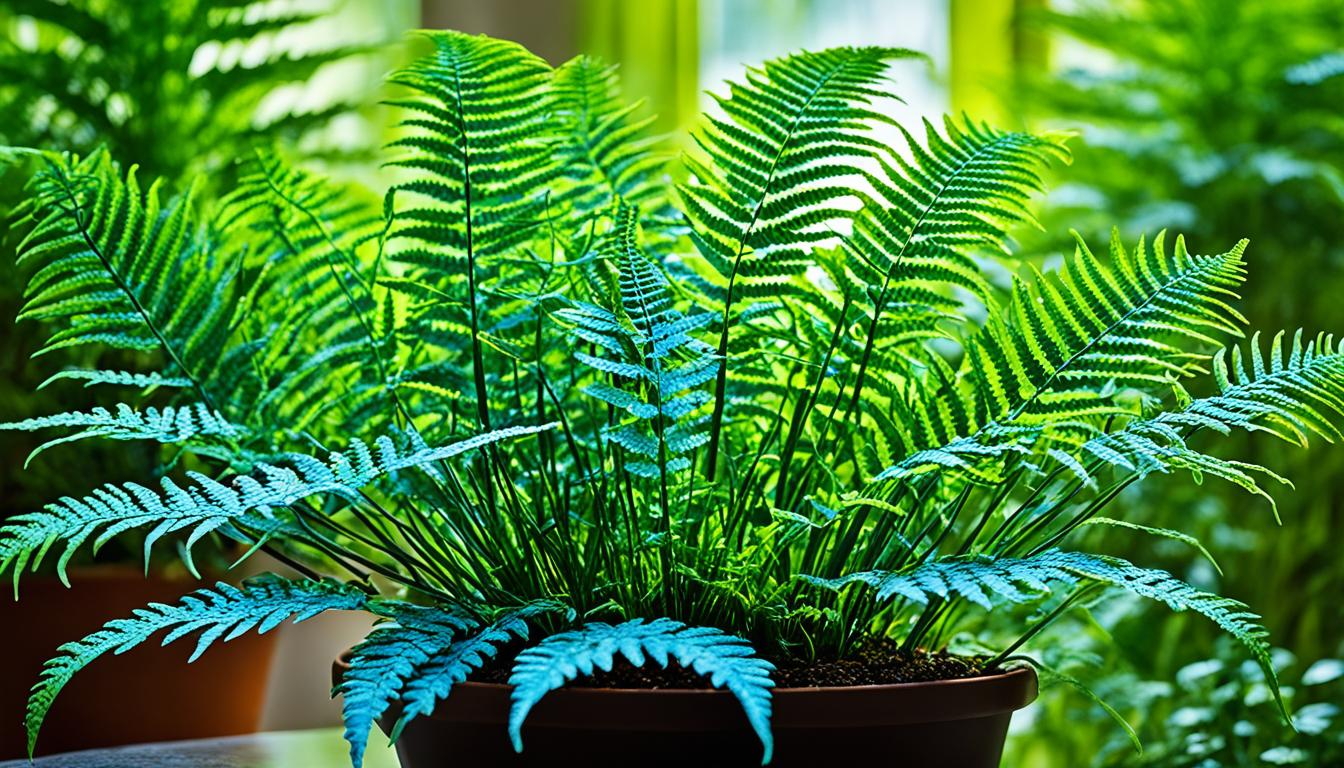Did you know Blue Star Ferns are amazing plants? They clean the air and are safe for pets. You’ll love having them in your home. They make your place look and feel better. This guide has all you need to care for them. Learn about how they look, grow, and what they need. I’ll also tell you how to multiply them and keep them healthy. Let’s make you a great Blue Star Fern parent!
Key Takeaways:
- Blue Star Ferns are pretty and clean the air.
- They are safe for pets, great for homes.
- This guide tells you how to take care of them.
- It covers their looks, growing, light, water, and more.
- You’ll learn everything to be the best plant parent.
Why Do We Love the Blue Star Fern For Apartments?
Blue Star Ferns are perfect for apartments because they look stunning and are easy to care for. These plants add beauty to any space and are great for apartment life.
Is the Blue Star Fern Air-Purifying?
Blue Star Ferns can clean the air. They remove bad stuff and add clean oxygen. This makes your home healthier and fresher.
Is the Blue Star Fern Pet-Friendly?
Blue Star Ferns are safe for pets. This makes them great for pet owners. They won’t hurt cats or dogs, so you can relax.
How Big Does the Blue Star Fern Get?
Blue Star Ferns don’t need much space. They grow to be about 1 to 2 feet big. This size is perfect for small places. You can easily put them on shelves or desks.
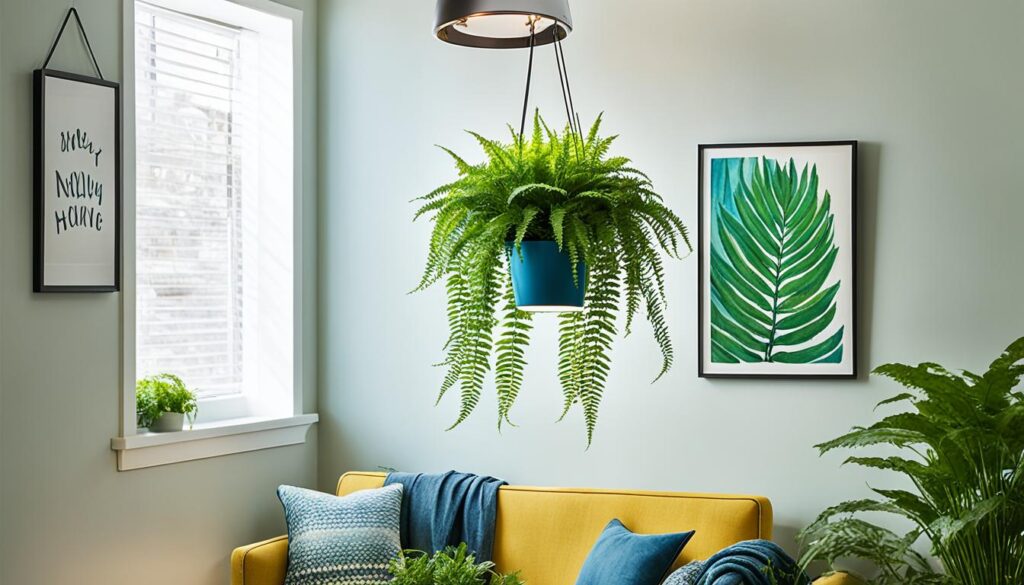
Table: Comparison of Blue Star Ferns’ Size
| Variety | Size |
|---|---|
| Blue Star Fern (Phlebodium aureum) | 1-2 feet in height and width |
| Golden Polypody (Phlebodium aureum ‘Golden Chimes’) | 1-2 feet in height and width |
| Cabbage Palm Fern (Phlebodium pseudocudipes) | 1-2 feet in height and width |
The Blue Star Fern and similar types are great for small apartments. They don’t take up much room and look beautiful.
We will talk about how to take care of Blue Star Ferns next. This will help them grow well in your home.
How to Grow a Blue Star Fern – Learn to Grow this Indoor Beauty
To grow Blue Star Ferns, you need to know a few things. I’ll tell you about choosing the right pot, soil, light, how to water, and more. You’ll also learn about keeping your plant healthy.
Choosing the Right Pot and Soil
Pick a pot with good drainage for your Blue Star Fern. Use a mix of peat moss, perlite, and organic matter for the soil. It helps roots breathe and prevents rot.
Providing Adequate Light
Blue Star Ferns do well in medium to bright, indirect light. Put your fern near a window for filtered light. Direct sunlight can hurt the leaves.
Watering and Humidity
Water your Blue Star Fern right to keep it healthy. The soil should be moist but not too wet. Make sure your pot drains well. These ferns like it humid, so maybe use a humidifier or water tray nearby.
Nutrition and Fertilization
Feed your fern with a balanced fertilizer once a month in spring and summer. Follow the instructions for mixing. Always water before feeding to avoid harm to the roots.
Pruning and Maintenance
Keep your fern looking good by removing dead or old fronds. Wipe the leaves gently with a damp cloth to help it get light.
Propagation
You can make new Blue Star Ferns by dividing them or using spores. Divide carefully and plant in new pots. To use spores, sow them in a moist place. Keep things warm and humid for the spores to grow.
Monitoring for Pests and Diseases
Check your fern for bugs like spider mites and mealybugs. Use safe soap or neem oil if you find pests. Watch for signs of sickness like root rot. Good air and not overwatering help prevent these.
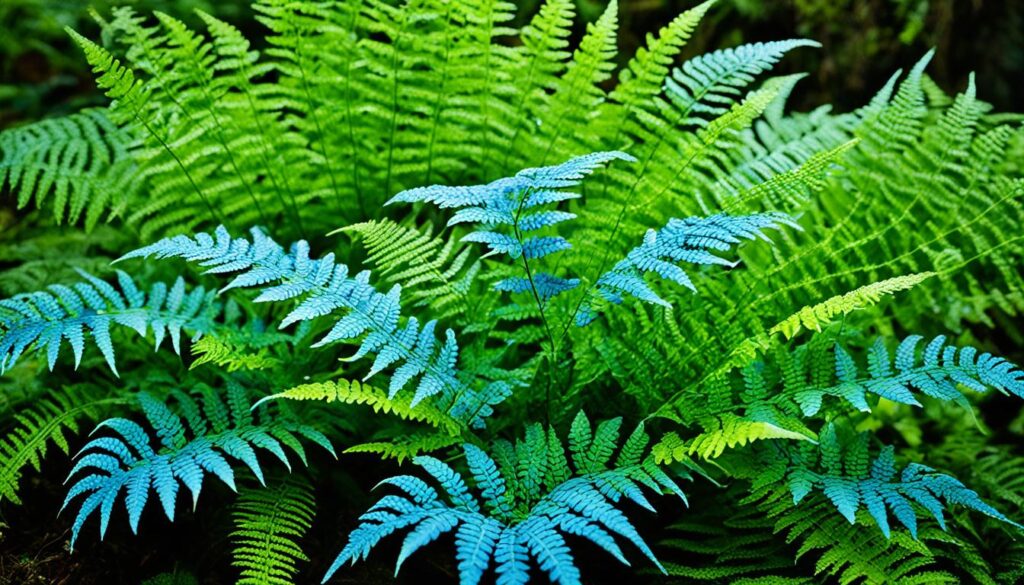
| Pests | Diseases |
|---|---|
| Spider mites | Root rot |
| Aphids | Leaf spot |
| Mealybugs |
Appearance of Blue Star Fern
The Blue Star Fern is unique among ferns. It has long, lobed fronds. These fronds look delicate and add elegance. They can grow quite long. This makes a lovely display.
It also has a blue-green color. This color makes it stand out. The fronds are darker on the bottom. They are lighter on the top. This creates a neat contrast.
There are other kinds of Blue Star Fern too. The Golden Polypody is one. It has golden fronds. They brighten up any room. Another kind is the Cabbage Palm Fern. Its fronds look like cabbage palm leaves. They have a cool shape and feel.
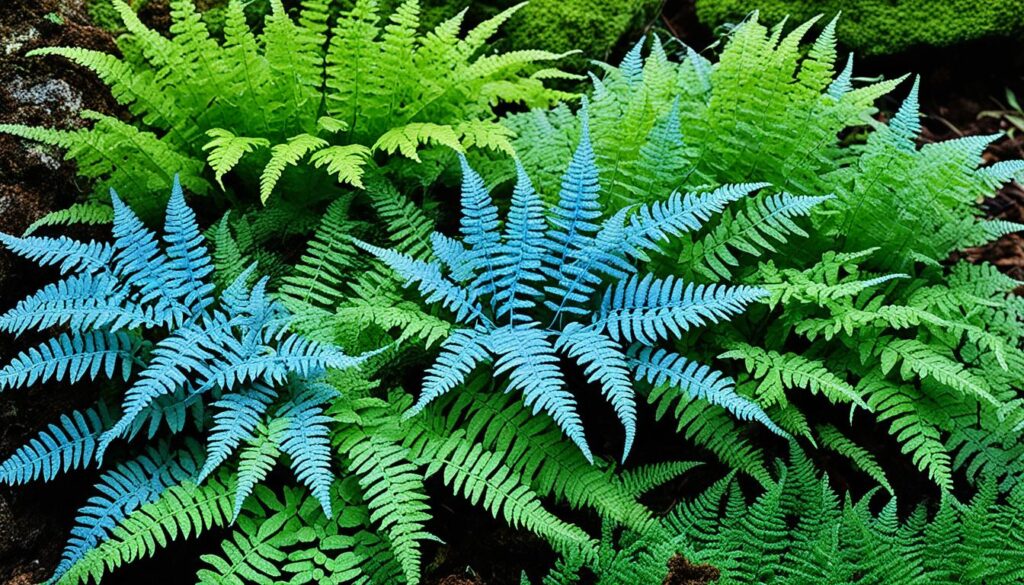
Light Requirements for Blue Star Fern
Blue Star Ferns need the right light to grow well. Knowing what they need helps them do their best. We’ll look at how much light Blue Star Ferns like. We’ll also see what happens if they get too much or too little.
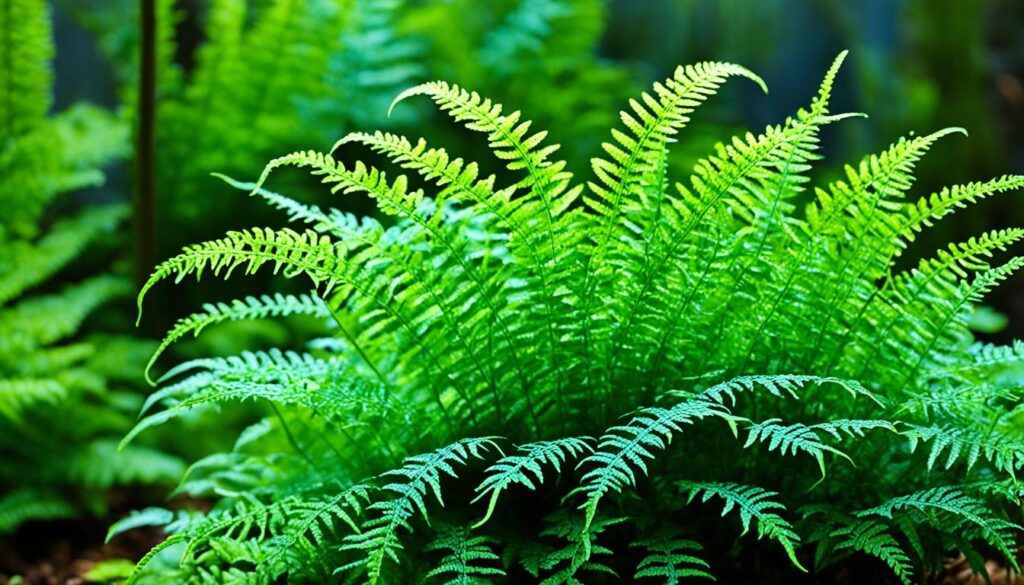
“Providing the right amount of light is crucial for the overall well-being of Blue Star Ferns. It directly influences their growth and leaf health.”
These plants can handle not having a lot of light. They are good for places that don’t get much sunlight. But, they still need some light to stay healthy and strong.
Blue Star Ferns like light, but not too much. They do best in bright places where the light is soft. Too much direct sun is bad for them. It can hurt their leaves.
A spot near a window that faces north or east is perfect. This gives them the gentle light they like. This keeps their leaves looking good.
Too much direct sun is bad for Blue Star Ferns. Their leaves might turn yellow or brown. not enough light can also be a problem. It makes the leaves lose their color and strength. The right amount of light keeps them looking fresh and green.
Check how your fern looks to see if it’s happy. If the leaves change color or look burnt, change where you placed it. Using thin curtains helps make the light just right.
Next, we will talk about how to water Blue Star Ferns right. We’ll cover what happens if they get too much or not enough water.
Watering Requirements of The Blue Star Fern
Proper watering keeps Blue Star Ferns healthy. We’ll look at their watering needs here. This includes how often to water. We’ll also talk about keeping the right moisture levels. Plus, we’ll cover what to watch for to avoid too much or too little water.
To help your Blue Star Fern grow well, learn how much water it needs. Blue Star Ferns like moist soil but can’t handle too much or too little water.
How often to water: Water Blue Star Ferns when the top soil feels dry. Usually, this means watering every 7 to 10 days. The need to water can change with the weather, air moisture, and type of soil.
Maintaining adequate moisture levels: Blue Star Ferns need moist but draining soil. Make sure the pot can let out extra water. This helps avoid soggy roots. When you water, wet the whole root area. Then let any extra water escape.
Signs of overwatering: Too much water can cause root rot and other problems. Yellow leaves, wilting, bad soil smell, and mold mean there’s too much water. Cut back on watering if you see these signs. Let the soil dry a bit more between waterings.
Signs of underwatering: Not enough water can lead to wilted plants, dry leaves, and slow growth. If the soil is dry and the fern looks thirsty, water more often. Make sure the soil gets fully wet each time you water.
This diagram shows what too much or too little water looks like:
| Signs of Overwatering | Signs of Underwatering |
|---|---|
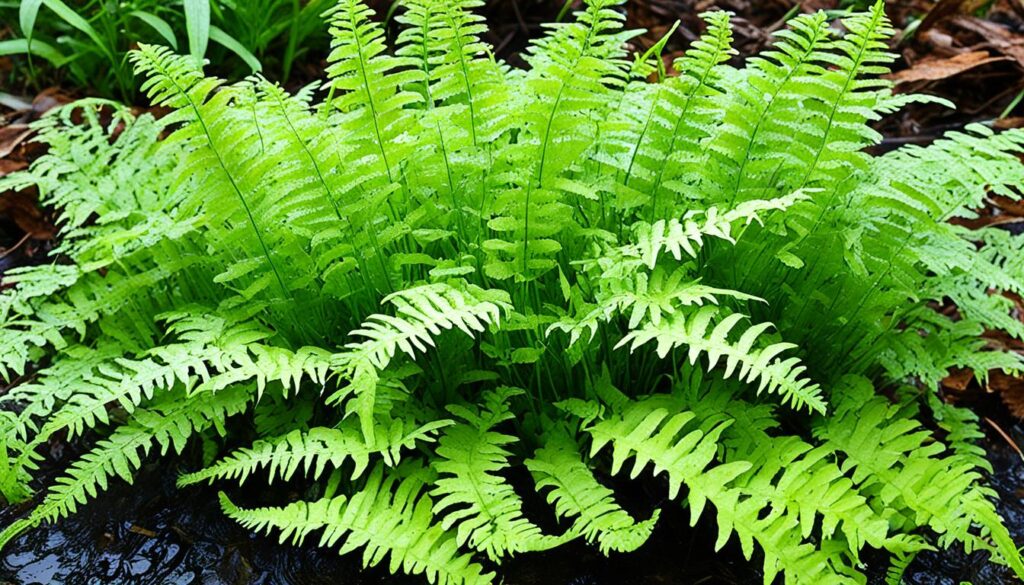 | 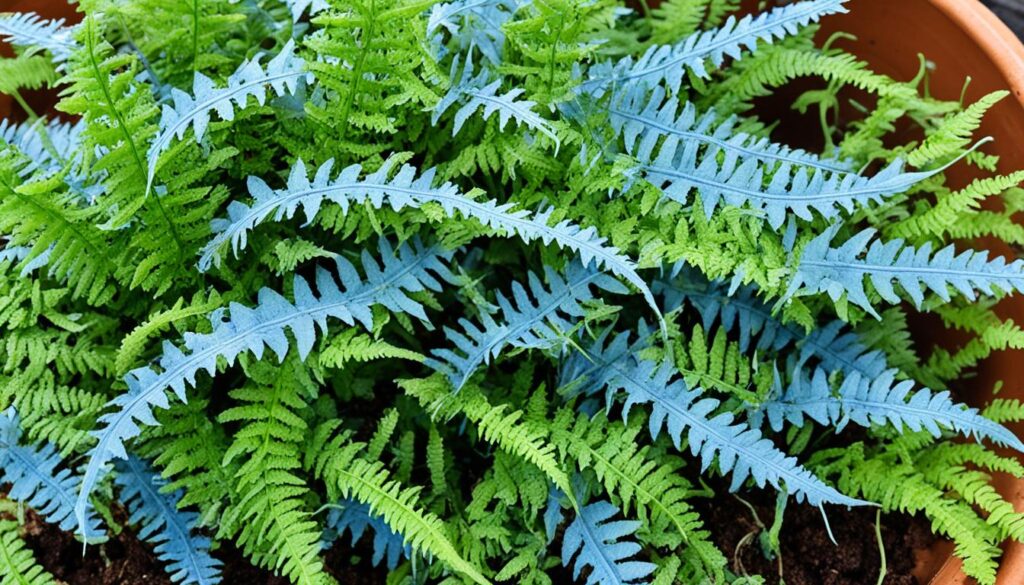 |
By knowing and following Blue Star Ferns’ watering needs, you help them stay healthy. They’ll be beautiful parts of your home for a long time.
Fertilizing Blue Star Ferns
Fertilizing Blue Star Ferns is very important. It helps them grow healthy and look good. In this section, we talk about how to fertilize them correctly. We’ll cover what fertilizer to use, how to apply it, and how often.
Recommended Fertilizer for Blue Star Ferns
Choosing the right fertilizer is key. Use a balanced, water-soluble one meant for indoor ferns. This kind of fertilizer has all the nutrients Blue Star Ferns need.
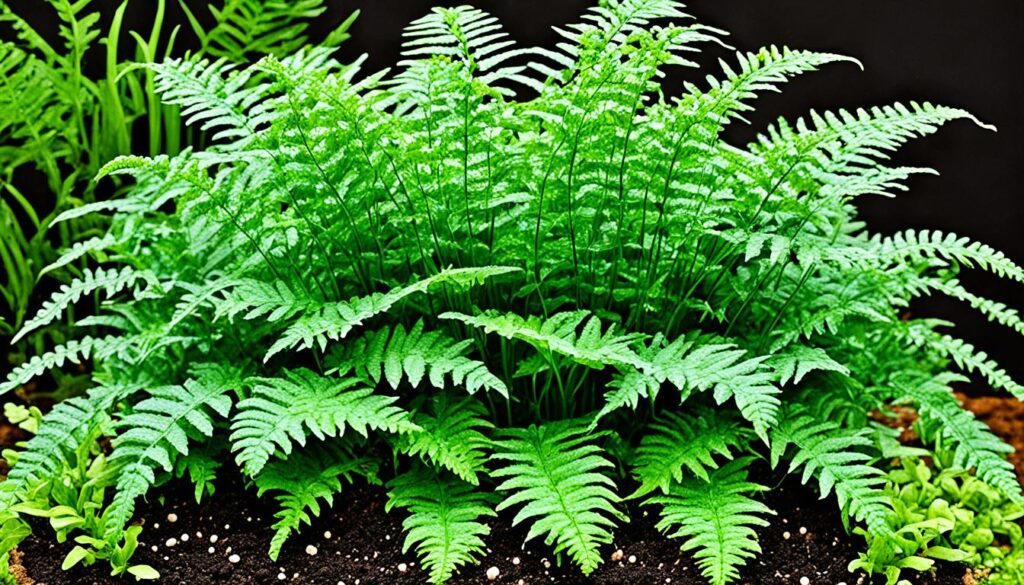
A good choice is a 10-10-10 balanced fertilizer. The numbers show how much nitrogen, phosphorus, and potassium it has. These nutrients are very important for the ferns.
Always dilute the fertilizer to half strength before using. This prevents harm to the ferns. Once a month in spring and summer is enough.
Always check the fertilizer’s package for how and when to use it.
Potting Blue Star Ferns
Getting the potting right is key for Blue Star Ferns to thrive. I’ll show you how to do it right. This includes picking the best pot size, the right soil mix, and repotting tips.
Choosing the Right Pot Size
Picking the right pot is important for the ferns’ root growth. It should be just the right size, as a too-big pot can cause too much water and rot. Make sure the pot has holes to drain water well.
Using the Right Potting Mix for Blue Star Ferns
The soil mix matters a lot for your fern’s health. Use a mix that drains well but keeps moisture.
Mix peat moss, perlite, and a bit of coarse sand. This blend makes sure your fern gets air, drains water well, and keeps the right amount of moisture.
Repotting When Necessary
Sometimes, your fern will need a new pot. You might see roots coming out of the pot, a lot of roots packed together, or the fern not growing much. Spring, when ferns grow more, is the best time to repot.
Carefully take the fern out of its pot, untangle the roots, and put it in a bigger pot with new soil. Always water it well right after to help it settle.
By using these tips, your Blue Star Ferns will grow well and be healthy.
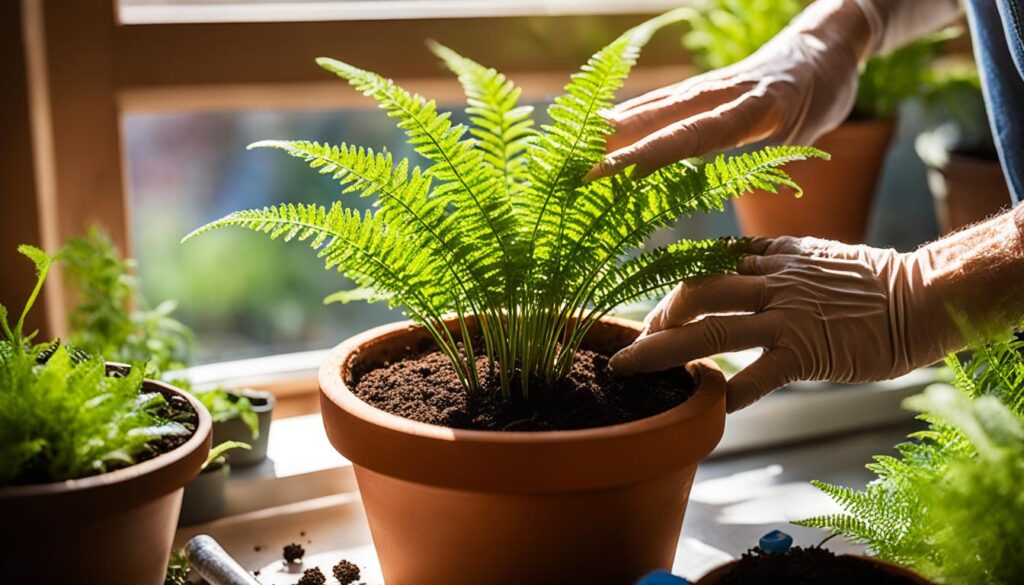
Propagating Blue Star Ferns
Making more Blue Star Ferns lets you grow your plant family or give some to friends. You can use stem cuttings or division to do this. Each way has different steps but we’ll make them simple for you.
Stem Cuttings or Seeds?
Stem cuttings are a way to make new Blue Star Ferns. You take a healthy piece from an adult plant and help it grow roots. This method is popular and works well for Blue Star Ferns.
To make a stem cutting, you do these things:
- Find a healthy piece on the big plant.
- Cut it right below a leaf or node with clean scissors.
- Take off the lower leaves but keep some at the top.
- Get a small pot ready with good soil and make a hole for the stem.
- You can use rooting powder (optional) and then put the stem in the hole.
- Press the soil gently to keep the stem steady.
- Water it a little and put it somewhere warm and bright but not in direct sun.
- Keep the soil moist and mist the stem to help it stay humid.
- In a few weeks, roots will grow and you can move it to a bigger pot.
Division is another way to make more Blue Star Ferns. It means making baby plants from one big plant. It’s good to do when your plant is too big for its pot.
Here’s how to divide a Blue Star Fern:
- Gently take the fern out of its pot, careful not to hurt the roots.
- Divide the fern into smaller pieces, making sure each has roots.
- Look for any bad parts and cut them off.
- Get pots ready for each piece with good soil.
- Plant each piece in its own pot, covering the roots well.
- Water the new plants and put them somewhere with light but no direct sun.
- Water them regularly as they grow new roots.
With stem cuttings or division, you can have more Blue Star Ferns. Just take good care of them as they start to grow, and you’ll have success.
Propagating Blue Star Ferns: Stem Cuttings vs Division
| Propagation Method | Advantages | Disadvantages |
|---|---|---|
| Stem Cuttings | – Can produce multiple new plants from a single stem – Generally faster than division | – Needs more care for the roots – Higher chance of not working if not cared for right |
| Division | – You get new plants right away with roots – Helps a too-big or not happy parent plant | – You only get a few new plants – Might need big pots for each |
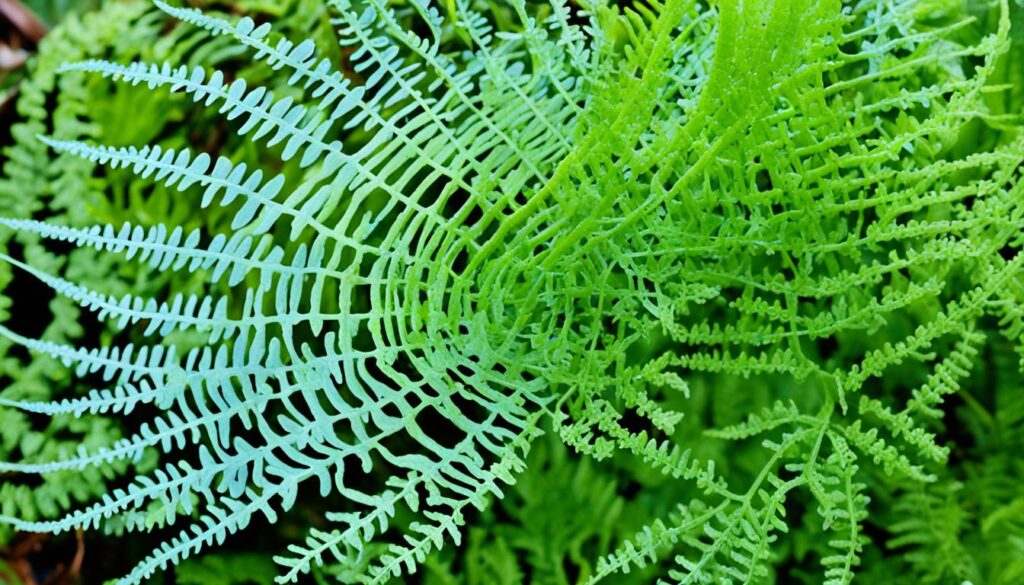
Growth and Development of Blue Star Ferns
Caring for Blue Star Ferns requires understanding their growth. We will look at how they grow. This includes their growth speed, usual size, and tips for strong, full leaves.
These ferns grow at a moderate pace, making them easy to maintain. Under the right conditions, they can get up to 12 to 20 inches tall and 12 to 18 inches wide. Size can change based on light, humidity, and food.
For big, healthy leaves, a perfect growing place is key. They need proper light, water in the air, and food. They do best with enough light but not direct sun and like the air a bit wet, around 50% to 60% humidity. Feeding them with good fertilizer regularly also helps make their leaves big and green.
Dealing with Pests and Diseases in Blue Star Ferns
Blue Star Ferns can get sick from pests and diseases. We will look at common problems like spider mites and thrips. Also, diseases such as root rot and crown rot. Ways to stop, find, and fix these issues will be covered.
Spider mites and thrips can really hurt Blue Star Ferns. Spider mites make leaves turn yellow and brown. Thrips make plants grow weird and change color.
Check your Blue Star Fern often for bugs. Look for tiny webs and spots on leaves. If you find bugs, keep the sick plant away from others. Then, treat it right away.
Root rot and crown rot can also happen. They are caused by too much water or bad soil. Make sure to water right and that water can drain away.
If your fern gets root or crown rot, act fast. Take it out of its pot. Cut off sick roots or the crown. Then, put it in new, draining soil. Change how you water and improve conditions.
| Pests | Signs of Infestation | Treatment |
|---|---|---|
| Spider Mites | Yellowing leaves, fine webbing | Prune affected leaves, apply insecticidal soap or neem oil |
| Thrips | Deformed growth, discoloration | Remove affected leaves, apply insecticidal soap or neem oil |
| Root Rot | Wilting, yellowing leaves, root discoloration | Remove affected roots, repot in fresh soil with good drainage |
| Crown Rot | Wilting, darkened crown area, foul smell | Remove affected crown, replant in fresh soil with good drainage |
Stay watchful and take action to keep your Blue Star Ferns safe. This way, they stay healthy and happy.
Common Blue Star Fern Pests
Blue Star Ferns can attract pests. These pests can hurt their leaves and growth. We will talk about spider mites, thrips, and fungus gnats. You will learn what they are, how to spot them, and how to get rid of them.
Spider mites are tiny and like warm, dry places. They eat the plant’s sap. This makes leaves change color and webs to appear. You can see yellow or brown spots and webbing on leaves if they are there. To fight spider mites, spray the fern with water or use special soap or neem oil.
Thrips are small bugs that also eat sap. They leave silver or bronze spots. They hide under leaves and can slow the plant’s growth. To deal with thrips, take off very bad leaves and keep checking the fern. Adding helpful bugs like mites or ladybugs can help too.
Fungus gnats are tiny flying bugs found near plants. They lay eggs in wet soil. The larvae eat the soil and roots. If you see small black flies or yellow leaves, they might be there. To stop them, let the soil dry a bit before watering again. Don’t water too much. Putting sand or special earth on top of the soil stops the larvae from coming out.
Natural Predators
Handling pests in Blue Star Ferns needs more than one way. Using natural predators is a smart choice along with other methods.
Ladybugs eat many pests that harm Blue Star Ferns. They are good at controlling aphids and other pests.
Lacewings and parasitic wasps are also helpful. They eat pests at different stages. This keeps the ecosystem balanced and protects your ferns. In addition to lacewings and parasitic wasps, introducing beneficial insects like ladybugs can further enhance your garden’s health by tackling aphid populations. For those looking to maintain a thriving environment for their ferns, it’s essential to adopt some effective birds nest fern care tips, such as ensuring proper humidity and avoiding direct sunlight. By creating a balanced ecosystem with these natural allies, your ferns will flourish and resist pest infestations more efficiently.
Isolate Infected Plants
It’s important to separate sick plants from healthy ones. Put them in a different place if possible.
This stops pests from spreading. It helps keep other plants safe while you deal with the problem.
Chemical Treatment
Sometimes, you need chemicals to fight off pests in Blue Star Ferns. There are many kinds to choose from.
Insecticidal soaps and neem oil can kill pests when sprayed. They help stop more pests from coming.
Systemic insecticides go into the plant. They kill pests that eat the plant. This includes hidden pests.
It’s important to use chemicals the right way. Be careful to protect good insects, the environment, and yourself.
Disease Prevention For Blue Star Ferns
Keeping Blue Star Ferns healthy is key. We’ll cover steps to keep your ferns disease-free. Doing so helps them grow well.
Proper watering techniques: Watering is super important for these ferns. Too much or too little water is bad. Just the right amount keeps them happy and disease-free.
Maintaining optimal humidity levels: These ferns love moist air. Making sure the air around them is just right is important. A humidifier or a water tray can help a lot.
Practicing good hygiene and sanitation practices: Clean ferns are happy ferns. Make sure to dust off their leaves often. Also, cut away any parts that look sick or old.
Know what diseases can hurt your ferns. Being able to spot trouble early is key. Here are some common problems:
- Root rot
- Crown rot
- Leaf spot
- Fungal infections
If you see your fern looking unwell, act fast. Take away sick leaves and keep it away from healthy plants. You might also need special medicine or expert help.
Use these tips to keep your Blue Star Ferns beautiful. With care and attention, they’ll stay healthy and strong. Enjoy their beauty for a long time!
Tips for Maintaining Blue Star Ferns
To keep your Blue Star Ferns healthy and beautiful, follow these tips. They will help your ferns grow well.
Wiping Leaves
Wiping the leaves regularly makes your ferns look nice. It also helps them get more light for food making.
Outdoor Exposure
Blue Star Ferns can go outside sometimes. But be careful with them. They need shade and don’t like cold or wind. Keep them safe from too much sun and bad weather.
Adjusting Watering Schedule
In hot months, your ferns need more water. In cold or dry times, they need less. Check the soil often. Change how much you water based on the weather and season.
| Maintenance Tip | Description |
|---|---|
| Wiping Leaves | Regularly wipe the leaves of your Blue Star Ferns to remove dust and debris, promoting better light absorption and overall plant health. |
| Outdoor Exposure | Be cautious when placing Blue Star Ferns outdoors, ensuring they are protected from direct sunlight, extreme temperatures, and strong winds. |
| Adjusting Watering Schedule | Monitor the soil moisture and adjust the watering schedule based on the season and environmental conditions to prevent overwatering or underwatering. |
Tips for Successful Overwintering of Blue Star Fern
Keeping Blue Star Ferns alive in winter needs special care. Follow these tips to help your fern thrive:
- Adjust light and temperature conditions: Blue Star Ferns need less sun and cooler temperatures in winter. Put your fern where it gets bright, indirect light. Keep it away from drafts and big temperature changes.
- Monitor humidity levels: Blue Star Ferns love moist air. Use a humidifier or a tray of water near your plant to keep the air wet. You can also spray the fronds to make the air around them moist.
- Make necessary adjustments to watering and fertilizing schedules: In winter, Blue Star Ferns grow slower and need less water and food. Let the soil dry a bit before watering again. Fertilize every 4-6 weeks with a weak houseplant food.
By using these tips, your Blue Star Fern can make it through winter. Give it the right care, and enjoy its beautiful leaves all year.
Growing Blue Star Fern from Seed
Most people grow Blue Star Ferns by dividing them. But, you can also grow them from seeds. We will talk about how to get and prepare the seeds. Then, we will create the right place for them to grow. Lastly, we will care for the young plants until they can be moved.
Varieties of Blue Star Fern
Blue Star Ferns come in different types. Each type has its own special look. We will look at some popular types like the Golden Polypody and Cabbage Palm Fern. We will talk about what makes them special and how to take care of them.
The Golden Polypody is up first. Its leaves are a lovely golden color. This makes any room feel warm. It likes lots of light but not direct sun. You should keep its soil moist. Yet, it’s okay if it dries out a bit between waterings. The Golden Polypody stands out because of its bright leaves.
Now, let’s talk about the Cabbage Palm Fern. Its leaves look like palm tree leaves. That’s why it got its name. It’s easy to care for because it can grow in less or more light. But don’t water it too much. It likes to dry out a little before getting water again. The Cabbage Palm Fern makes any place look more elegant.
Caring for these Blue Star Fern types is easy if you follow some basic rules. Make sure they have enough light and water. Also, they like the air around them to be a bit moist. Remember, each type might need something a little different. So, it’s good to know what each one likes to help them do well.
FAQ
Q: Why do people love the Blue Star Fern for apartments?
A: People love Blue Star Ferns for their beautiful look. They are easy to care for. They make indoor spaces pretty. They also clean the air and are safe for pets.
Q: Is the Blue Star Fern air-purifying?
A: Yes, they clean the air. They get rid of toxins.
Q: Is the Blue Star Fern pet-friendly?
A: Yes, it’s safe for cats and dogs. But watch your pets around it. Talk to a vet if you’re worried.
Q: How big does the Blue Star Fern get?
A: It can grow 12 to 18 inches tall. But size varies by type and care.
Q: How do I choose the right pot and soil for my Blue Star Fern?
A: Pick a pot with holes to avoid too much water. Use a potting mix that drains well but holds moisture.
Q: What are the light requirements for Blue Star Ferns?
A: They like indirect light. Too much sun isn’t good. They do well in bright rooms.
Q: How often should I water my Blue Star Fern, and what are the signs of overwatering or underwatering?
A: Water it when the top inch of soil is dry. Too much water causes root rot.
Yellow leaves mean too much water. Wilting means it’s too dry.
Q: What fertilizer is recommended for Blue Star Ferns?
A: Use a balanced fertilizer half strength. Do this every 4 to 6 weeks in warm months.
Q: How do I choose the right pot size for my Blue Star Fern?
A: Use a pot 1-2 inches bigger than the current one. Too big pots can hold too much water.
Q: How do I propagate Blue Star Ferns?
A: You can split the plant or use stem cuttings. For cuttings, use water or soil to root.
Q: What are the common pests and diseases that affect Blue Star Ferns?
A: They might get spider mites or fungus gnats. Too much water can cause root rot.
Q: How can I control pests and diseases in my Blue Star Fern?
A: Keep infected plants away. Use natural sprays for bugs. Good care stops diseases.
Q: How do I maintain my Blue Star Fern?
A: Clean the leaves and let it stay outside sometimes. Change how much you water it by the season.
Q: How do I overwinter my Blue Star Fern?
A: Keep it in the right light and warmth during winter. Check how humid it is. Adjust water and food.
Q: Can I grow Blue Star Ferns from seeds?
A: You can grow them from seeds. Prepare the seeds well. Take care of them until they can be moved.
Q: What are the different varieties of Blue Star Fern?
A: There are many types, like the Golden Polypody. Each one is a bit different.

